Showing Spotlights 401 - 408 of 544 in category All (newest first):
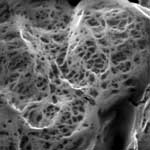 Collagen is one of the most essential and plentiful proteins in humans, making up about one quarter of all proteins in the body. It is also a major component of connective tissue such as cartilage, ligaments, tendons, bone and skin. Due to its excellent biocompatibility, biodegradability, and the ease of extraction, purification, and processing, collagen has found use as a versatile biomaterial in numerous medical applications. However, collagen is susceptible to biodegradation and the mechanical stability of native collagen for use in tissue repair is insufficient. In order to slow down the biodegradation rate, researchers have developed numerous chemical cross-linking techniques where individual protein chains are linked with a covalent bond, thereby stabilizing the protein. Scientists have now proposed a novel approach to collagen cross-linking on the basis of gold nanoparticles, opening a path to using collagen as a medium for delivery of drug molecules.
Collagen is one of the most essential and plentiful proteins in humans, making up about one quarter of all proteins in the body. It is also a major component of connective tissue such as cartilage, ligaments, tendons, bone and skin. Due to its excellent biocompatibility, biodegradability, and the ease of extraction, purification, and processing, collagen has found use as a versatile biomaterial in numerous medical applications. However, collagen is susceptible to biodegradation and the mechanical stability of native collagen for use in tissue repair is insufficient. In order to slow down the biodegradation rate, researchers have developed numerous chemical cross-linking techniques where individual protein chains are linked with a covalent bond, thereby stabilizing the protein. Scientists have now proposed a novel approach to collagen cross-linking on the basis of gold nanoparticles, opening a path to using collagen as a medium for delivery of drug molecules.
Jan 21st, 2009
 Typically, nanoparticles have been used for drug delivery and it has been only recently that carbon nanotubes (CNTs) have gained attention as potential drug delivery vehicles. Carbon nanotubes offer a number of advantages which suggest that they may provide an improved result over nanoparticles. They have a larger inner volume which allows more drug molecules to be encapsulated, and this volume is more easily accessible because the end caps can be easily removed, and they have distinct inner and outer surfaces for functionalization. Current research has shown the ability of CNTs to carry a variety of molecules such as drugs, DNA, proteins, peptides, targeting ligands etc. into cells - which makes them suitable candidates for targeted delivery applications. Despite these advantages, a suitable delivery system has not been developed yet for the targeted delivery of CNTs to specific sites.
A research team from various Canadian and U.S. universities has now demonstrated, for the first time, the design and development of a novel microcapsule carbon nanotube targeted delivery device.
Typically, nanoparticles have been used for drug delivery and it has been only recently that carbon nanotubes (CNTs) have gained attention as potential drug delivery vehicles. Carbon nanotubes offer a number of advantages which suggest that they may provide an improved result over nanoparticles. They have a larger inner volume which allows more drug molecules to be encapsulated, and this volume is more easily accessible because the end caps can be easily removed, and they have distinct inner and outer surfaces for functionalization. Current research has shown the ability of CNTs to carry a variety of molecules such as drugs, DNA, proteins, peptides, targeting ligands etc. into cells - which makes them suitable candidates for targeted delivery applications. Despite these advantages, a suitable delivery system has not been developed yet for the targeted delivery of CNTs to specific sites.
A research team from various Canadian and U.S. universities has now demonstrated, for the first time, the design and development of a novel microcapsule carbon nanotube targeted delivery device.
Jan 19th, 2009
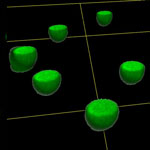 Conventional vaccine development is based on the body's successful approach to dealing with viral infections. Unfortunately, standard vaccine technologies are ineffective against some of the most devastating infectious diseases such as HIV. A key role in developing cell-mediated immunity against viruses is played by so-called T-cells, which belong to a group of white blood cells known as lymphocytes. One variant of T-cells (cytotoxic T lymphocytes) directly attacks body cells that are infected with a virus or malignant or abnormal tumor cells. These 'killer' T-cells are called into action by 'helper' T-cells, which also activate other immune cells to produce antibodies. HIV, though, takes over helper T-cells and uses them to replicate itself. A major focus in AIDS research has therefore been the development of a 'T-cell vaccine' that induces T-cell immunity. While it was shown that peptides in blood could effectively stimulate T cell immunity in monkeys, and peptides are considered safe vaccine antigens, proteases in vivo can rapidly degrade peptide-based vaccines and this has limited their utility to date. New research by scientists in Australia represents an important finding for vaccine delivery as it demonstrates a feasible method for protecting biologically active peptides for delivery to antigen presenting cells (APCs).
Conventional vaccine development is based on the body's successful approach to dealing with viral infections. Unfortunately, standard vaccine technologies are ineffective against some of the most devastating infectious diseases such as HIV. A key role in developing cell-mediated immunity against viruses is played by so-called T-cells, which belong to a group of white blood cells known as lymphocytes. One variant of T-cells (cytotoxic T lymphocytes) directly attacks body cells that are infected with a virus or malignant or abnormal tumor cells. These 'killer' T-cells are called into action by 'helper' T-cells, which also activate other immune cells to produce antibodies. HIV, though, takes over helper T-cells and uses them to replicate itself. A major focus in AIDS research has therefore been the development of a 'T-cell vaccine' that induces T-cell immunity. While it was shown that peptides in blood could effectively stimulate T cell immunity in monkeys, and peptides are considered safe vaccine antigens, proteases in vivo can rapidly degrade peptide-based vaccines and this has limited their utility to date. New research by scientists in Australia represents an important finding for vaccine delivery as it demonstrates a feasible method for protecting biologically active peptides for delivery to antigen presenting cells (APCs).
Jan 13th, 2009
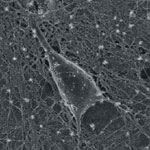 Neural engineering is an emerging discipline that uses engineering techniques to investigate the function and manipulate the behavior of the central or peripheral nervous systems. Neural engineering is highly interdisciplinary and relies on expertise from computational neuroscience, experimental neuroscience, clinical neurology, electrical engineering and signal processing of living neural tissue, and encompasses elements from robotics, computer engineering, neural tissue engineering, materials science, and nanotechnology. In order for neural prostheses to augment or restore damaged or lost functions of the nervous system they need to be able to perform two main functions: stimulate the nervous system and record its activity. To do that, neural engineers have to gain a full understanding of the fundamental mechanisms and subtleties of cell-to-cell signaling via synaptic transmission, and then develop the technologies to replicate these mechanisms with artificial devices and interface them to the neural system at the cellular level. A group of European researchers has now shown that carbon nanotubes may become the ideal material for repairing damaged brain tissue.
Neural engineering is an emerging discipline that uses engineering techniques to investigate the function and manipulate the behavior of the central or peripheral nervous systems. Neural engineering is highly interdisciplinary and relies on expertise from computational neuroscience, experimental neuroscience, clinical neurology, electrical engineering and signal processing of living neural tissue, and encompasses elements from robotics, computer engineering, neural tissue engineering, materials science, and nanotechnology. In order for neural prostheses to augment or restore damaged or lost functions of the nervous system they need to be able to perform two main functions: stimulate the nervous system and record its activity. To do that, neural engineers have to gain a full understanding of the fundamental mechanisms and subtleties of cell-to-cell signaling via synaptic transmission, and then develop the technologies to replicate these mechanisms with artificial devices and interface them to the neural system at the cellular level. A group of European researchers has now shown that carbon nanotubes may become the ideal material for repairing damaged brain tissue.
Dec 29th, 2008
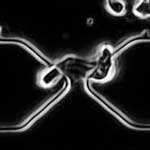 Miniaturizing traditional laboratory assays to automated lab-on-a-chip devices holds tremendous potential for enabling multiplex, efficient, cost-effective and accurate pathogen sensing systems for both security and medical applications. These sensors could be used to detect bacteria such as E. coli and Salmonella, but also other pathogens that could be used for bioterrorism. Traditional identification methods required time intensive cell culturing processes but novel pathogen sensors based on nanomaterials are promising vastly improved and speedy detection technologies. A recent example is a label-free sensor chip assembled from peptide nanotubes that enables the electrical detection of viruses with an extremely low detection limit. This could lead to compact super-sensitive pathogen detection chips for point of care applications that have a high tolerance against false-positive signals.
Miniaturizing traditional laboratory assays to automated lab-on-a-chip devices holds tremendous potential for enabling multiplex, efficient, cost-effective and accurate pathogen sensing systems for both security and medical applications. These sensors could be used to detect bacteria such as E. coli and Salmonella, but also other pathogens that could be used for bioterrorism. Traditional identification methods required time intensive cell culturing processes but novel pathogen sensors based on nanomaterials are promising vastly improved and speedy detection technologies. A recent example is a label-free sensor chip assembled from peptide nanotubes that enables the electrical detection of viruses with an extremely low detection limit. This could lead to compact super-sensitive pathogen detection chips for point of care applications that have a high tolerance against false-positive signals.
Dec 2nd, 2008
 Quantum dots are emerging as an important class of nanoparticles with applications ranging from medicine to energy. These nanocrystals possess size tunable optical and electronic properties resulting from quantum confinement which allow them to be suitable candidates for applications in solar cells and light emitting devices. For instance, quantum dots have been identified as important light harvesting material for building highly efficient solar cells - when exposed to light at certain wavelengths they can generate free electrons and create an electrical current. Having a high resistance to photobleaching, quantum dots (QDs) also are attractive materials for optoelectronics and in vivo biosensing. Researchers have now demonstrated that QDs, in addition to being excellent fluorescent probes, can be used as photoacoustic (which combines the advantages of optical absorption contrast with ultrasonic spatial resolution for deep imaging) and photothermal contrast agents and sensitizers, thereby providing an opportunity for multimodal high resolution photoacoustic/photothermal-fluorescent imaging as well as sensitizers in nanotherapeutic applications.
Quantum dots are emerging as an important class of nanoparticles with applications ranging from medicine to energy. These nanocrystals possess size tunable optical and electronic properties resulting from quantum confinement which allow them to be suitable candidates for applications in solar cells and light emitting devices. For instance, quantum dots have been identified as important light harvesting material for building highly efficient solar cells - when exposed to light at certain wavelengths they can generate free electrons and create an electrical current. Having a high resistance to photobleaching, quantum dots (QDs) also are attractive materials for optoelectronics and in vivo biosensing. Researchers have now demonstrated that QDs, in addition to being excellent fluorescent probes, can be used as photoacoustic (which combines the advantages of optical absorption contrast with ultrasonic spatial resolution for deep imaging) and photothermal contrast agents and sensitizers, thereby providing an opportunity for multimodal high resolution photoacoustic/photothermal-fluorescent imaging as well as sensitizers in nanotherapeutic applications.
Nov 12th, 2008
 Developed originally for the surface finishing industry, diamond nanoparticles are now finding new and far-reaching applications in modern biomedical science and biotechnologies. Due to its excellent biocompatibility, diamond has been called the Biomaterial of the 21st Century and medical diamond coatings are already heavily researched for implants and prostheses. Nanoscale diamond is also being discussed as a promising cellular biomarker and a non-toxic alternative to heavy metal quantum dots. Further extending the nanomedical use of diamond, researchers now have demonstrated a nanodiamond-embedded device that could be used to deliver chemotherapy drugs locally to sites where cancerous tumors have been surgically removed.
Developed originally for the surface finishing industry, diamond nanoparticles are now finding new and far-reaching applications in modern biomedical science and biotechnologies. Due to its excellent biocompatibility, diamond has been called the Biomaterial of the 21st Century and medical diamond coatings are already heavily researched for implants and prostheses. Nanoscale diamond is also being discussed as a promising cellular biomarker and a non-toxic alternative to heavy metal quantum dots. Further extending the nanomedical use of diamond, researchers now have demonstrated a nanodiamond-embedded device that could be used to deliver chemotherapy drugs locally to sites where cancerous tumors have been surgically removed.
Nov 7th, 2008
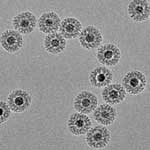 Mesoporous materials, i.e. materials with pores that measure less than 50 nanometers in size, have been researched extensively for at least 20 years now. Especially mesoporous silicates, due to their large surface area, their uniform pore size, and the accessibility of these pores, have become very popular as catalyst materials and excellent dug delivery candidates. Despite of the long research history of mesoporous silica materials and their biomedical potential, there have been only few reports on actual in vivo applications. Although the theory looks good, there are several practical obstacles for mesoporous silica materials to be used as drug carriers or for instance as in vivo cancer targeting agents. Researchers who tried making small mesoporous silica particles with sizes of around 100 nm often ended up with much larger lumps of aggregated particles. These larger chunks cannot be used because, due to their size, they are easily trapped in the body's defense mechanism, the reticuloendothelial system (RES). Researchers in South Korea have now reported the fabrication of discrete, monodisperse, and precisely size-controllable core?shell nanoparticles that are smaller than 100 nm, by using single magnetite nanocrystals as core and a mesoporous silica shell.
Mesoporous materials, i.e. materials with pores that measure less than 50 nanometers in size, have been researched extensively for at least 20 years now. Especially mesoporous silicates, due to their large surface area, their uniform pore size, and the accessibility of these pores, have become very popular as catalyst materials and excellent dug delivery candidates. Despite of the long research history of mesoporous silica materials and their biomedical potential, there have been only few reports on actual in vivo applications. Although the theory looks good, there are several practical obstacles for mesoporous silica materials to be used as drug carriers or for instance as in vivo cancer targeting agents. Researchers who tried making small mesoporous silica particles with sizes of around 100 nm often ended up with much larger lumps of aggregated particles. These larger chunks cannot be used because, due to their size, they are easily trapped in the body's defense mechanism, the reticuloendothelial system (RES). Researchers in South Korea have now reported the fabrication of discrete, monodisperse, and precisely size-controllable core?shell nanoparticles that are smaller than 100 nm, by using single magnetite nanocrystals as core and a mesoporous silica shell.
Nov 6th, 2008
 Collagen is one of the most essential and plentiful proteins in humans, making up about one quarter of all proteins in the body. It is also a major component of connective tissue such as cartilage, ligaments, tendons, bone and skin. Due to its excellent biocompatibility, biodegradability, and the ease of extraction, purification, and processing, collagen has found use as a versatile biomaterial in numerous medical applications. However, collagen is susceptible to biodegradation and the mechanical stability of native collagen for use in tissue repair is insufficient. In order to slow down the biodegradation rate, researchers have developed numerous chemical cross-linking techniques where individual protein chains are linked with a covalent bond, thereby stabilizing the protein. Scientists have now proposed a novel approach to collagen cross-linking on the basis of gold nanoparticles, opening a path to using collagen as a medium for delivery of drug molecules.
Collagen is one of the most essential and plentiful proteins in humans, making up about one quarter of all proteins in the body. It is also a major component of connective tissue such as cartilage, ligaments, tendons, bone and skin. Due to its excellent biocompatibility, biodegradability, and the ease of extraction, purification, and processing, collagen has found use as a versatile biomaterial in numerous medical applications. However, collagen is susceptible to biodegradation and the mechanical stability of native collagen for use in tissue repair is insufficient. In order to slow down the biodegradation rate, researchers have developed numerous chemical cross-linking techniques where individual protein chains are linked with a covalent bond, thereby stabilizing the protein. Scientists have now proposed a novel approach to collagen cross-linking on the basis of gold nanoparticles, opening a path to using collagen as a medium for delivery of drug molecules.
 Subscribe to our Nanotechnology Spotlight feed
Subscribe to our Nanotechnology Spotlight feed





